What was going through J. Robert Oppenheimer’s head when he saw the great fireball of the Trinity test looming above him? According to his brother, Frank, he only said, “it worked.” But most people know a more poetic account, one in which Oppenheimer says (or at least thinks) the following famous lines:
I remembered the line from the Hindu scripture, the Bhagavad-Gita; Vishnu is trying to persuade the Prince that he should do his duty and, to impress him, takes on his multi-armed form and says, “Now I am become Death, the destroyer of worlds.” I suppose we all thought that, one way or another.
This particular version, with a haggard Oppenheimer, was originally filmed for NBC’s 1965 The Decision to Drop the Bomb. I first saw it in Jon Else’s The Day After Trinity (1980), and thanks to YouTube it is now available pretty much anywhere at any time. There are other versions of the quote around — “shatterer of worlds” is a common variant — though it did not begin to circulate as part of Los Alamos lore until the late 1940s and especially the 1950s.
It’s a chilling delivery and an evocative quote. The problem is that most of the time when it is invoked, it is done purely for its evocativeness and without any understanding as to what it actually supposed to mean. That’s what I want to talk about: what was Oppenheimer trying to say, presuming he was not just trying to be gnomic? What was he actually alluding to in the Gita?
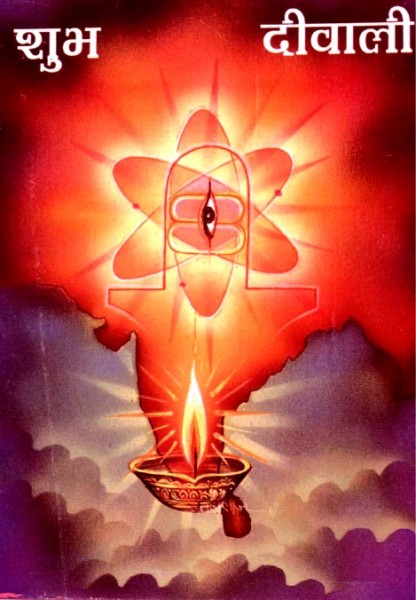
An Indian greeting card for Diwali from 1998, celebrating India’s nuclear tests. Source.
I should say first that I’m no scholar of Hindu theology. Fortunately, many years back, James A. Hijiya of the University of Massachusetts Dartmouth wrote a wonderful article on “The Gita of J. Robert Oppenheimer” that covers all of this topic as well as one might ever want it to be covered. 1 Everything I know about the Gita comes from Hijiya’s article — so read it if you want much more discussion of this than I have here. I am particularly fond of Hijiya’s opening line, that Oppenheimer’s paraphrase of the Gita is “one of the most-cited and least-interpreted quotations” of the atomic age.
Oppenheimer was not a Hindu. He was not much of anything, religiously — he was born into a fairly secular Jewish family, embraced the Ethical Culture of Felix Adler, and saw philosophy as more of a boon to his soul than any particular creed. He enjoyed the ideas of the Gita, but he was not religious about it. Hijiya thinks, however, that much can be understood about Oppenheimer’s life through the lens of the Gita as a philosophical and moral code, something necessary in part because Oppenheimer rarely discussed his own internal motivations and feelings about making the bomb. It helps explain, Hijiya argues, that a man who could utter so many public statements about the “sin” and “terror” and “inhumanity” of Hiroshima and Nagasaki could also have been the one who pushed for their use against Japan and who never, ever said that he actually regretted having built the bomb or recommending its use. It helps resolve one of the crucial contradictions, in other words, at the heart of the story of J. Robert Oppenheimer.
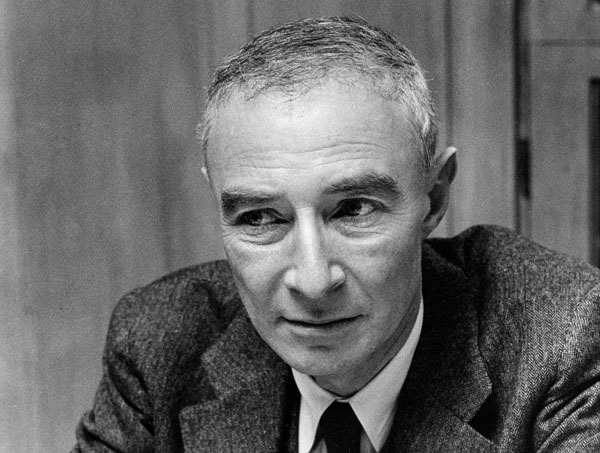
J. Robert Oppenheimer, from the Emilio Segrè Visual Archives.
It’s not clear when Oppenheimer was first exposed to the Gita. I have seen accounts, in oral histories, that suggested that he was spouting Gita lines even while he was a young graduate student studying in Europe. What is definitely known is that he didn’t start studying Sanskrit seriously until 1933, when he started studying with the renown Sanskrit scholar Arthur W. Ryder while he was a professor at Berkeley. In letters, he wrote gushingly about the book to his brother, and much later he quoted from it at the service held at Los Alamos in April 1945 upon the death of President Roosevelt.
The story of the Gita is that of Arjuna, a human prince who has been summoned to a war between princely cousins. Arjuna doesn’t want to fight — not because he lacks courage, or skill, but because it is a war of succession, so his enemies are his own cousins, his friends, his teachers. Arjuna does not want to kill them. He confides in his charioteer, who turns out to be the god Krishna 2 in a human form. The text of the Gita is mostly Krishna telling Arjuna why Arjuna must go to war, even if Arjuna does not want to do it.
Krishna’s argument hinges on three points: 1. Arjuna is a soldier, and so it is his job — his duty — to wage war; 2. It is Krishna’s job, not Arjuna’s, to determine Arjuna’s fate; 3. Arjuna must ultimately have faith in Krishna if he is going to preserve his soul.
Arjuna eventually starts to become convinced. He asks Krishna if he will show him his godlike, multi-armed form. Krishna obliges, showing Arjuna an incredible sight:
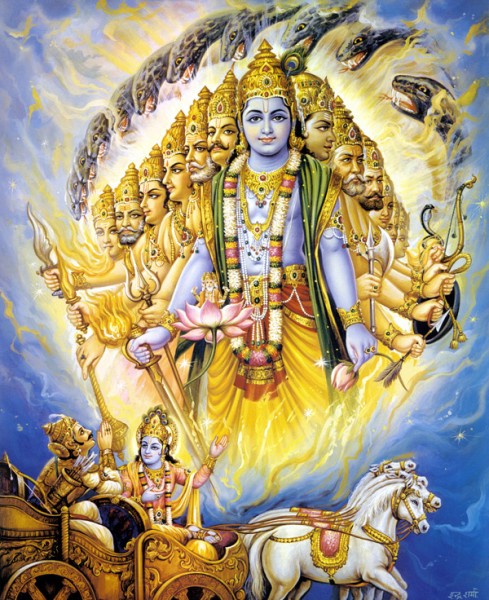
Krishna revealing himself to Arjuna. Source.
A thousand simultaneous suns
Arising in the sky
Might equal that great radiance,
With that great glory vie.
Arjuna is awestruck and spellbound:
Amazement entered him; his hair
Rose up; he bowed his head;
He humbly lifted folded hands,
And worshipped God. . . .
And then, in his most amazing and terrible form, Krishna tells Arjuna what he, Krishna, is there to do:
Death am I, and my present task
Destruction.
Arjuna, suitably impressed and humbled, then agrees to join in the battle.
The above quotes are from Ryder’s translation of the Gita. You can see that Oppenheimer’s is not especially different from that, even if it is somewhat changed. Personally I find Ryder’s version of the last part more impressive — it is more poetic, more stark. Ryder’s translation, Hijiya explains, is a somewhat idiosyncratic but defensible one. What Ryder (and Oppenheimer) translate as “Death,” others have translated as “Time,” but Hijiya says that Ryder is not alone for calling attention to the fact that in this context the expanse of time was meant to be a deadly one.
If you would like to see the famous “death” verse in the original, it is chapter 11, verse 32 of the Gita, and looks like this:
This website (from which I got the above) translates it as:
Lord Krsna said: I am terrible time the destroyer of all beings in all worlds, engaged to destroy all beings in this world; of those heroic soldiers presently situated in the opposing army, even without you none will be spared.
While I find Ryder’s more poignant, the longer translation makes it extremely clear what Krishna has in mind. All will perish, eventually. In war, many will perish whether you participate or not. For Oppenheimer and the bomb, this may have seemed especially true. The cities of Hiroshima and Nagasaki (and others on the target list) were on it not because they were necessarily the most important, but because they had so far been spared from firebombing. They were being actively preserved as atomic bomb targets. Had the bomb not been used or made, they probably would have been firebombed anyway. Even if the physicists had refused to make nuclear weapons, the death toll of World War II would hardly have been altered.
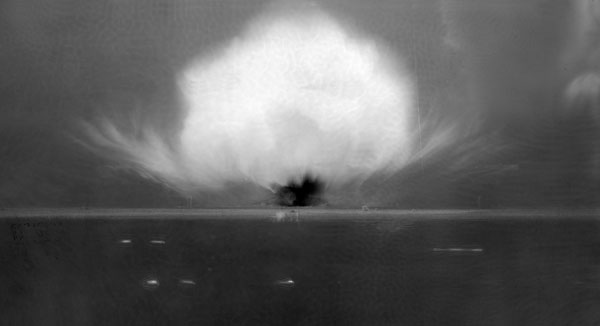
“A thousand simultaneous suns”: a long-exposure shot of the Trinity test.
So let’s step back and ask who Oppenheimer is meant to be in this situation. Oppenheimer is not Krishna/Vishnu, not the terrible god, not the “destroyer of worlds” — he is Arjuna, the human prince! He is the one who didn’t really want to kill his brothers, his fellow people. But he has been enjoined to battle by something bigger than himself — physics, fission, the atomic bomb, World War II, what have you — and only at the moment when it truly reveals its nature, the Trinity test, does he fully see why he, a man who hates war, is compelled to battle. It is the bomb that is here for destruction. Oppenheimer is merely the man who is witnessing it.
Hijiya argues that Oppenheimer’s sense of Gita-inspired “duty” pervades his life and his government service. I’m not sure I am 100% convinced of that. It seems like a heavyweight philosophical solution to the relatively lightweight problem of a life of inconsistency. But it’s an interesting idea. It is perhaps a useful way to think about why Oppenheimer got involved with so many projects that he, at times, seemed ambivalent about. Though ambivalence seemed readily available in those days — nobody seems to be searching for deep scriptural/philosophical justifications for Kenneth Bainbridge’s less eloquent, but equally ambivalent post-Trinity quote: “Now we’re all sons-of-bitches.”
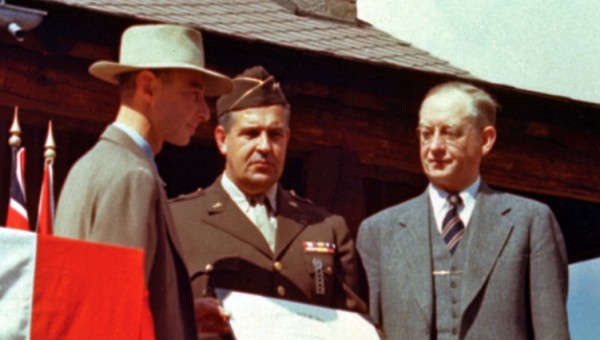
A rare color photograph of Oppenheimer from October 1945, with General Groves and University of California President Robert Sproul, at the Army-Navy “E” Award ceremony. Source.
One last issue that I find nagging me. We have no recording of Oppenheimer saying this except the 1965 one above. By this time, Oppenheimer is old, stripped of his security clearance, and dying of throat cancer. It is easy to see the clip as especially chilling in this light, given that is being spoken by a fading man. How would it sound, though, if it was coming from a younger, more chipper Oppenheimer, the one we see in photographs from the immediate postwar period? Would it be able to preserve its gravity?
Either way, I think the actual context of the quote within the Gita is far deeper, far more interesting, than the popular understanding of it. It isn’t a case of the “father” of the bomb declaring himself “death, the destroyer of worlds” in a fit of grandiosity or hubris. Rather, it is him being awed by what is being displayed in front of him, confronted with the spectacle of death itself unveiled in front of him, in the world’s most impressive memento mori, and realizing how little and inconsequential he is as a result. Compelled by something cosmic and terrifying, Oppenheimer then reconciles himself to his duty as a prince of physics, and that duty is war.
- James A. Hijiya, “The Gita of J. Robert Oppenheimer,” Proceedings of the American Philosophical Society 144, no. 2 (June 2000), 123-167.[↩]
- Oppenheimer, in his 1965 interview, identifies the god as Vishnu, perhaps in error. Krishna is an avatar of Vishnu, however, so maybe it is technically correct along some line of thinking.[↩]



Great analysis, Alex, I’ve always been a bit skeptical because of what Frank described that Oppie actually said the quote at Trinity. He certainly may have said it to himself, but your point in the second to last paragraph is right on. Thanks for sharing — and let us know when you want to come visit his house!
Thanks, Alex. Your analysis makes sense. “Duty” is a concept that has brought us many wars. I find it mind-boggling that Arjuna does his duty by joining the war, even though he will kill his relatives. I wonder if we are detaching ourselves from this kind of duty. T.S. Eliot’s use of the Krishna-Arjuna situation in “The Dry Salvages” from his “Four Quartets” has always felt creepy to me.
I sometimes wonder if that is what Krishna meant-
Among other things – or one way of putting the same thing:
That the future is a faded song, a Royal Rose or a lavender spray
Of wistful regret for those who are not yet here to regret,
Pressed between yellow leaves of a book that has never been opened.
And the way up is the way down, the way forward is the way back.
You cannot face it steadily, but this thing is sure,
That time is no healer: the patient is no longer here.
….
‘on whatever sphere of being
The mind of a man may be intent
At the time of death’ – that is the one action
(And the time of death is every moment)
Which shall fructify in the lives of others:
And do not think of the fruit of action.
Fare forward.
O voyagers, O seamen,
You who came to port, and you whose bodies
Will suffer the trial and judgement of the sea,
Or whatever event, this is your real destination.”
So Krishna, as when he admonished Arjuna
On the field of battle.
Not fare well,
But fare forward, voyagers.
This carries more of a feeling of destiny propelling the actor forward, but the sense that the actor must not focus on the “fruit of action” overlaps with the duty Krishna lays on Arjuna.
Eliot wrote the poem during World War II, so Oppenheimer was not the only one contemplating this mix of duty and destiny at the time.
More duty from “The Charge of the Light Brigade”:
1.
Half a league, half a league,
Half a league onward,
All in the valley of Death
Rode the six hundred.
“Forward, the Light Brigade!
“Charge for the guns!” he said:
Into the valley of Death
Rode the six hundred.
2.
“Forward, the Light Brigade!”
Was there a man dismay’d?
Not tho’ the soldier knew
Someone had blunder’d:
Theirs not to make reply,
Theirs not to reason why,
Theirs but to do and die:
Into the valley of Death
Rode the six hundred.
Your interpretation appears very sound, Alex. The lines from the Gita (11:32) aren’t about death, but the passing of time in which all will perish. Bear in mind that Vishnu is the Preserver who presides over time, while Shiva is the Destroyer. The translation I like is that of George Thompson: “”I am time, the agent of the world’s destruction, now grown old and set in motion to destroy the worlds. Even without you, all of these warriors arrayed in opposing battle-formation will cease to exist!” I’m not a Sanskrit expert on the exact translation, but this seems to best capture the spirit of Krishna’s declaration. For further discussion of Oppenheimer and the Gita, see Steven J. Rosen’s “Krishna’s Song: A New Look at the Bhagavad Gita”, chapter 12, in which Rosen acknowledges Hijiya’s article (which you cite) as the best exegesis on this subject.
Here is what I had to say on the subject a dozen years ago, the final paragraphs of “The Holocaust Bomb, a question of time”:
http://www.fas.org/sgp/eprint/morland.html
Every story about Los Alamos eventually gets around to quoting Oppenheimer on the occasion of the world’s first nuclear explosion, July 16, 1945: “I remembered the line from the Hindu scripture, the Bhagavad-Gita… ‘Now I am become death, the destroyer of worlds.’ I suppose we all thought that, one way or another.” I read two English translations of the Bhagavad-Gita, obtained from Hare Krishna panhandlers in U.S. airports, and I couldn’t find that line. The only reference to world destruction in the Bhagavad-Gita comes in verse thirty-two of chapter eleven, which is usually translated: “The Lord said, ‘I am Time grown old to destroy the world, Embarked on the course of world annihilation.'”*
Time, not death, is the destroyer of worlds. When Oppenheimer watched the Trinity fireball rise into the New Mexico sky, what he saw was time running out. Time will eventually destroy our world. The sun will inflate and consume the earth. Before that, a comet the size of Hale-Bopp may collide with the earth, or a killer virus may sweep the planet. The only world-destroying event we have control over is nuclear Armageddon; it will come when we allow it.
Right now we have time to retake the test we failed in 1950, but we don’t have forever.
* The Bhagavad-Gita, 11:32, translation by J.A.B. Van Buitenen, introduction by Alexandre Piatigorsky, Element Books, Rockport MA, 1997. Of the six translations I have seen, only one translates this passage as Oppenheimer did. In all the others, the word “kalah,” or “kalo” in the line “kalo ‘smi loka-ksaya-krt pravrttah,” is translated as time not death. Generally, where the word death appears in English translation, such as 9:3, 9:19, 10:34, and 13:9, the Sanskrit word is mrtyuh, not kalah. Obviously, time and death are related, as in John Maynard Keynes’ famous statement, “In the long run, we are all dead.”
I was actually trying to make fun of Oppenheimer by implying that he didn’t know what he was talking about.
Or maybe we’re over-analyzing it: maybe Oppie was reminded, as the cloud mushroomed up, of the impressive vision of the giant multi-armed god, simply as a physical picture.
Brilliant piece of writing, Alex.
MK
—There is cable television movie, or mini-series, called “Manhattan,” about the Manhattan Project coming up in a few months. Will you write about it?
—I read somewhere that a Soviet-made film about the Manhattan Project was made, and the source document was supposed to be “Brighter than a Thousand Suns,” which I thought had the unreliable “The thing is superb physics” quote in it.
—Do you know anything about the Soviet made film, and if the actor playing Oppie said those words in the film?
On “Manhattan,” I might! I have informally consulted with them a bit on and off over the last year, so I’m interested to see what it is.
I haven’t seen any Soviet film, but would love to see it.
http://en.wikipedia.org/wiki/Take_Aim_(1974_film)
—This may be the film I read about.
You have said you can tead russian. I believe this website article is about a film that includes actors playing “The Beard,” and it might include actors playing Oppie and Leslie Groves.
http://kinofilms.tv/film/vybor-celi/31942/
http://www.whosdatedwho.com/tpx_745001/vybor-tseli/
Minor point, but Oppenheimer was not “old” at the time of the 1965 recording, in fact he was just over 60. Of course he looks older, but that might be a result of his illness, or simply the fact that he always looked older than his true age (during the Manhattan Project he was barely 40 but looked well into middle age).
True enough. He is definitely haggard though, had been drinking quite a lot in the last decade, and dying. (He was diagnosed with throat cancer in late 1965, and dead by February 1967.)
http://www.kinomania.ru/film/71505/trailers/
—-This is somewhat confusing: this seems to be the right movie, and some of the language is in German, and some in the English language, the scene seems to be the capture German scientists held by the UK in 1945.
I found this biography to be a source of wonderful insight into the mind of the very brilliant and complex man. His brilliance, clarity, and open mind clearly disturbed or offended many less enlightened men. Thankfully, Eisenhower and Kennedy did eventually recognize him, and that he had been wronged by the establishment. Alan Turing certainly suffered more thoroughly. : http://www.amazon.com/American-Prometheus-Triumph-Tragedy-Oppenheimer/dp/0375726268
I agree, the Bird and Sherwin biography is excellent, maybe the best one out there so far.
On Turing, I’ve thought a bit about the comparisons between the two. One of the key differences is that Oppenheimer became famous for his work during the war, which was publicized dramatically in the days after Hiroshima. So even while Oppenheimer was “wronged,” it was clear to a lot of the public (not just his close friends) that he was being wrong. Turing’s role in the war was still secret until the 1970s, so almost nobody knew what was happening to him (it wasn’t front-page news) and why it was such a tragedy for the government to do it to such a hero (aside from the general barbarity of prosecuting homosexuals, which of course wasn’t seen as such at the time). I suspect that if Turing’s work had been declassified earlier, and his role as a “scientific hero” had been more prominent, his fate might have been different, though it is hard to say, given the different nature of their persecutions.
The Turing story is a fascinating example of lost opportunities and failed government policies – the key point is that British government hid the fact that it had broken German encryption, and then distributed captured German ENIGMA cryptography machines to its former colonies, telling them they now had unbreakable communications – while secretly being able to read all of those communications. This was however an enormous economic blunder – publication of Turing’s results and techniques would have made Britain the center of computer science development in the 20th century, giving them a leading edge everywhere (they had secretly invented public key cryptography, as well) – what a missed opportunity. Instead, they persecuted the greatest genius of his day in the area of information science to his death. Talk about missed opportunities.
This verse should not be understood in isolation.
Gita is a very complex and highly misunderstood book.
People usually see it as a jumble of contradictions.
There is no God or such at subtle levels in the Gita.
Any way, this verse is just one link in the full 700 links of
the Gita in 18 chapters.
Sankara’s commentary (Sanskrit) is the only
authoritative commentary. He just quotes this verse
in the passing without giving elaborate interpretations.
We have to understand a few Hindu concepts to understand this shloka.
-death is not a finality since atman/consciousness/soul is immortal and merely migrates from one organism to another in a cycle of reincarnations.
– Just as physical bodies are born, mature and die so does the universe also undergoes cycles of creation, evolution and dissolution.
-Dharma is the all encompassing moral order etched in spacetime and the soul ascends or descends into higher or lower conscious states on the basis of its adherence to this dharma. When human dharma attains God state the soul attains ‘moksha’, which is a state of “being,consciousness and bliss”.
-although dharma is deterministic the soul has Free Will to choose his Karma/deeds and its on the basis of his karma that a man ascends or lowers his consciousness, suffering/enjoying its fruits on Earth, before migrating to the next body.
Furthermore, the Hindu God Krishna is none other than the ‘universe’ itself urging Arjuna to exercise his Free Will on the basis of his Kshatriya/warrior dharma. The dharma of a warrior is not to just wage a war, but wage a war to protect the dharma which protects humanity at large. Its to be noted here that Hindus regard ‘ahimsa/non-violence as the greatest dharma’, and violence is sanctioned only as a last resort. The conflict here is about the interpretation of ahimsa/non-violence as pacifism/inaction or violence/action. Arjuna does not want to fight this war for worldly comforts and is overcome with remorse for his brethren.
Krishna urges Arjuna to wage a war to protect humanity from decaying into adharmic/non-righteous activities. He is ‘time become mature’, because, most of the warriors in the opposite camp have chosen to fight on the side of adharma. With so much decay in humanity its now time to dissolve the universe so it can be recreated again.
Krishna tells Arjuna in a later verse that he is merely an instrument as even without Arjuna’s intervention all the warriors in the opposite camp will perish because they have chosen to fight an unjust war. However, Arjuna is the chosen warrior who will become the cause of their death on the basis of his past reincarnations.
The message is that violence for a just cause is right but only if it pressed in service to protect the larger good. ‘Ahimsa/Non-violence is the greatest dharma,,but paradoxically violence is unavoidable to destroy evil.
Great. Perfectly explained. One need to understand the Hindu Philosophy of life in order to under stand the meaning of Bhagawad gita. Unlike Abrahamic religions,Which revolves around Rule-Book and blasphemy, Indic religions lays stress on the way of life parallel to Dharma. Ideas are complicated and would transform random,materialistic thoughts towards Eternal-Truth. So Ancient Indians self posed a simple Question “Who Am I?” If not understood, answer is as complicated as Hindu philosophy, if Understood, if is as simple as “Tatwamasi” means “That is I am” means we are all part of the same ONE thing there is has always been there.Such realization comes meditation as well. Such idea is totally absent in Abrahamic religions.
Very interesting analysis – and take a look at this classic photo of Oppenheimer and Groves at Trinity, right after the test – they both look to be very flushed with success, not pensive or doubtful:
http://commons.wikimedia.org/wiki/File:Trinity_Test_-_Oppenheimer_and_Groves_at_Ground_Zero_002.jpg
Historically, I get the impression that Oppenheimer was an ardent advocate of the development and use of the fission bomb – for example, even after intelligence made it clear c. winter 1944 that German efforts towards a fission bomb were non-existent, he still continued to push for its development (and the threat of a German bomb was clearly the driving force behind the entire Manhattan Project).
As I understand it, Oppenheimer was only opposed to the development of the fission-fusion-fission ‘thermonuclear’ weapon that Dr. Edward T. Strangelove was such a strong advocate of, and that’s what all the controversy was about. He thought (with good reason, in my opinion) that the thermonuclear program was unnecessary and wasteful – after all, if you can make D-T boosted fission bombs with an ~500 kT yield, why go beyond that?
The photo of Oppenheimer and Groves is actually from early September 1945, so well after the bombs seemed to have “worked.” It was part of a “press safari” to the Trinity site that Groves helped organized. But in any case the accounts of Oppenheimer after Trinity are of a satisfied man, someone who achieved success under extreme stress.
Oppenheimer’s approach to the bomb is nuanced and sometimes contradictory. He supported the H-bomb once it became clear that one could be built; he only opposed it when it seemed that it would siphon resources from the fission program.
My favorite A-bomb, “The Mark 18 nuclear bomb, also known as the SOB or Super Oralloy Bomb,”
was D-T boosted, or not?
I’ve never read anything that suggested it was boosted; it is usually described as “pure-fission” which I always have assumed meant unboosted.
After an extremely stimulating discussion with my undergrad class this week I came to think that perhaps what Oppenheimer is referring to is the transformation of the discipline of physics from an exciting intellectual adventure, a field of freewheeling inquiry driven by the urge to know more about the structure of matter, into a practice driven by the pursuit of lethal applications, a change that was irreversible (or so he realized when he made the statement). This puts considerable emphasis on the last section of the quote, ” I suppose we all thought that, one way or the other” — i.e. this is a collective sense of loss –, and less emphasis on the deeper significance of the citation from the Gita. It also dovetails with Paul Forman’s idea that after the war physicists were reduced to gadgeteers.
My argument would be strengthened if we had a good idea of what Oppenheimer felt about doing physics as a young man and in the interwar period. Help Alex!